Opulent but visually structured, repetitive but methodical, Matt Mullican’s solo exhibition at the Rosenwald-Wolf Gallery unfolds a universe of signs which illuminates the artist’s obsessive quest to find meaning in lived experience, human interaction, and memory. In diverse media from prints to videos, the artist creates a visual cluster of images and signs, text fragments and arrows, pattern and colored limitations. In this clearly structured and sensible presentation, the works develop into a mind-map or vivid encyclopedia which is both in its obsession, compulsive, and, in its details, repelling.
Systematic symbolism
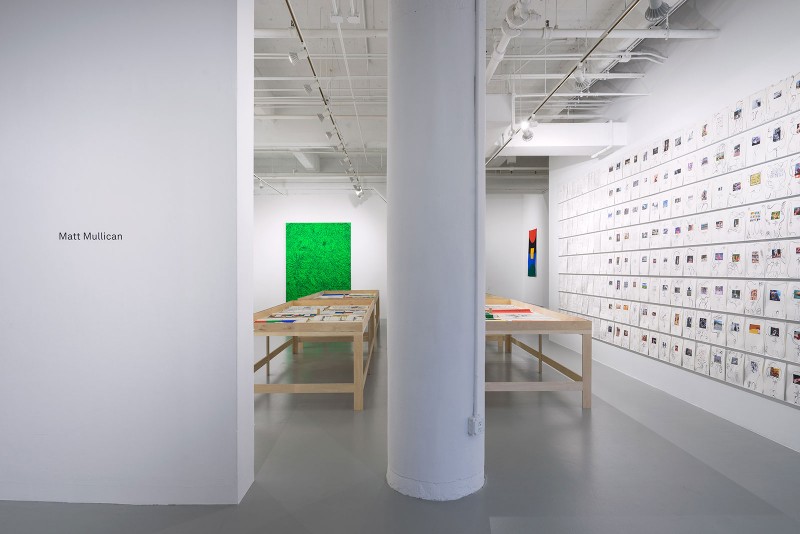
The systematic repetition of subjects and motives in all nine exhibited pieces seems conceptually akin to Aby M. Warburg’s “Mnemosyne Atlas”. The German art historian assembled in the 1920s picture series of photographic reproductions of paintings, book excerpts, and newspaper images in thematic and motivic sequences on wooden boards to foster insights into the visual memory of European culture, in particular into the antiquity’s afterlife in Italian Renaissance art and its cartographic differences in styles and gestures.
Employing Aby Warburg’s philosophical and art-historical approach to Matt Mullican’s work, visitors are invited to immerse themselves in the artist’s distinct world of symbolic meaning, bridging the sensation of real images with their mental reflections. In the main gallery space, the two works “88 Maps” (2010) and “The Meaning of Things” (2014) especially illustrate Mullican’s world of thoughts. At the same time, these two extensive graphical series are interlinked like satellites with the surrounding works in the exhibition.
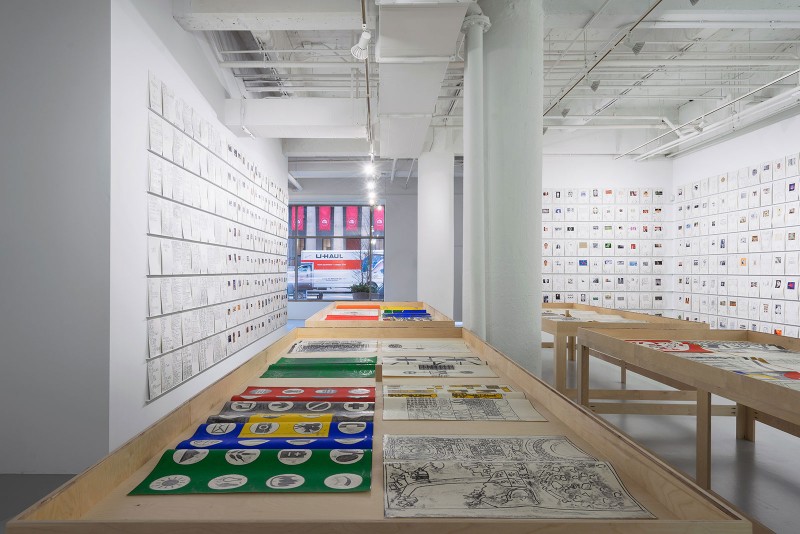
(Foreground) “88 Maps” (2010), courtesy of the artist and Mai 36 Galerie. (Background) “The Meaning of Things” (2014), courtesy of the artist and ProjecteSD. Photo credit: Studio LHOOQ
A cosmos of signs
Twenty-eight graphite rubbings comprise the book “88 Maps” (2010), presented in four vitrines in the center of the main room. Graphical structures of lines and fields, geometrical patterns, and grids as well as symbolical icons are printed on different colored papers. Apparently Matt Mullican initially sketches gesturally black lines like networks of thoughts on white paper, which he systematically repeats and expands into a complex nexus of emblematic icons, crossing connections and explaining transcriptions.
A multi-layered geometric layout on white paper (two half-circles on each side of a rectangle, with multi-perspectival inversions of the same pattern) is a notable highlight of this portfolio. Like a baroque garden ensemble—systematically arranged, detailed and mirrored—or like a trompe-l’œil by Giovanni Battista Piranesi in which each line is related to another point or object, this graphic model refers to the textile work “Untitled (Indian Banner)” from 1979—reduced to color and abstracted in manner—and the portfolio “Solway II” from 1993, both exhibited in the last room. Furthermore, Mullican transcribed and rendered his symbolic system in the virtual 3-dimensional space of two digital videos, “5 into 1” and “The Computer Project” from the early 1990s, which are presented in the gallery’s entryway. As early investigations of virtual reality, the maze portrayed by the camera creates a kind of video game scenery.
Matt Mullican seems to represent in his geometrical drawings, colored fields, and digital animations the world as an ambiguous construction, a kind of sign system, which is shaped by human thinking, design and technology. “Within Mullican’s universe,” writes Sid Sachs, the curator and director of the gallery, “colors signify order: the material world (green), the as-yet-uncultured (blue), culture (yellow), the arena of signs and language (black and white) and subjective experience (red).” Order and systematization are crucial in his work. They seem to create a cosmos of sign language in which the combination of colored areas with marking lines, figurations like machinery, symbols and pattern provoke the impression of a utopian space—a space inhabited by the chaos of nature on the one side, culture as conciliating medium and human invention on the other pole.
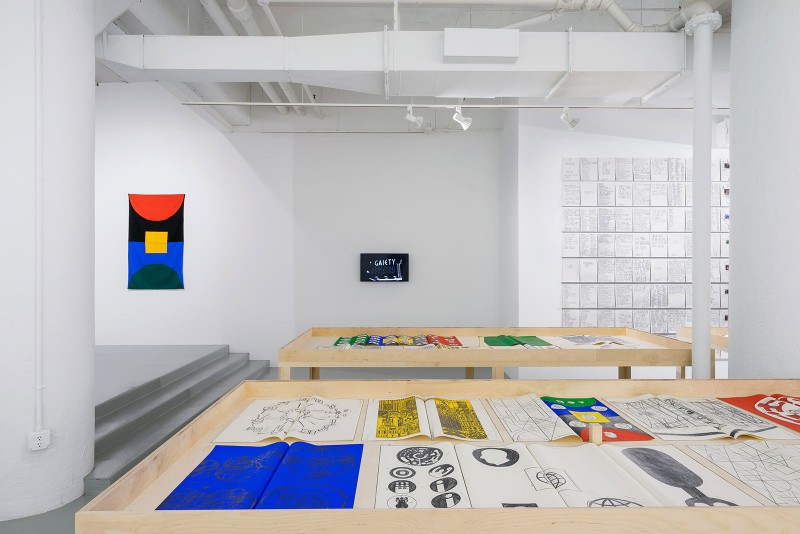
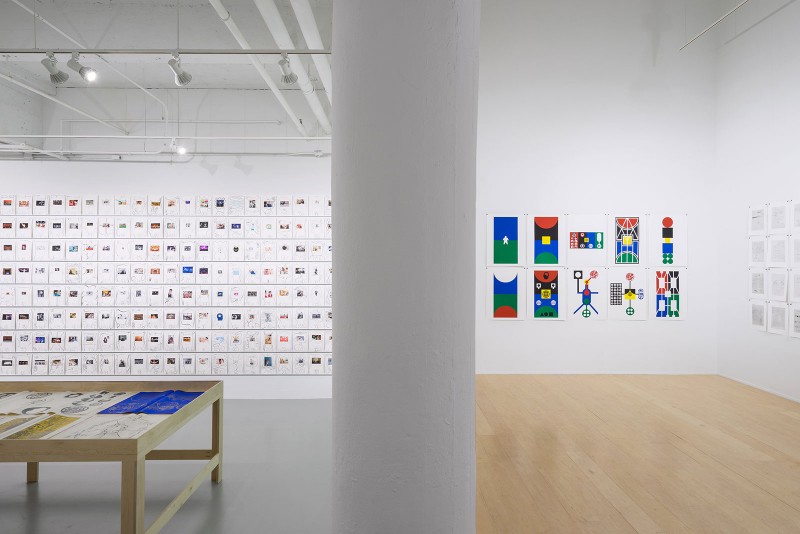
Facing the world
A hidden order also seems to conceal the enormous 676-sheet-long paper work “The Meaning of Things” (2014). At first glance, Mullican seems to illustrate an introductory text, citing parts of his poetical text “Essex” (1973) exhibited in the entryway. On white sheets, he juxtaposes cut-out images surrounded by calligraphic drawings and serially ordered numbers at the bottom of each paper. The progressive and impulsive language of the excerpt seems to be mirrored in the existential and in some sense archaic topics of the images. Pain and death, gestures and theatrical stages, emotions and pornography, celebrities and icons are the big issues circulating over the 600 collages.
Anda Smithson’s detailed Artblog essay on this piece anchors Mullican’s analysis of an “Imaginary Life” (the poem’s subtitle) in hypnotic techniques and links it to a Freudian existential narrative. Smithson points out that stressing hypnosis allows the artist to elevate his “curation” of digital images (presumably taken from the Internet) on a meta-level and interconnects the virtual origin of the printout back to reality.
At second glance, this re-convergence to the real is, in my belief, essential in Matt Mullican’s work, particularly illustrated in the visual impression of wounded bodies, death masks, praying hands or mimetic expressions of “fear,” after a photograph from Guillaume Duchenne (compare to number 180 in the image shown below). The small images are digital reproductions of our everyday world, showing (historical) situations, acknowledged objects and signs. While confronting the real, viewers are challenged to assemble thematic issues and motives, and in this sense, it might be rather a form of appropriation than hypnotic narration. In the serial repetition and content sequencing, viewers are facing an abstract collage of their surrounding environment. That means the selected images seem to draw a visual cluster of significant icons and actions we might be guided by, chafe at, resist or strive towards.
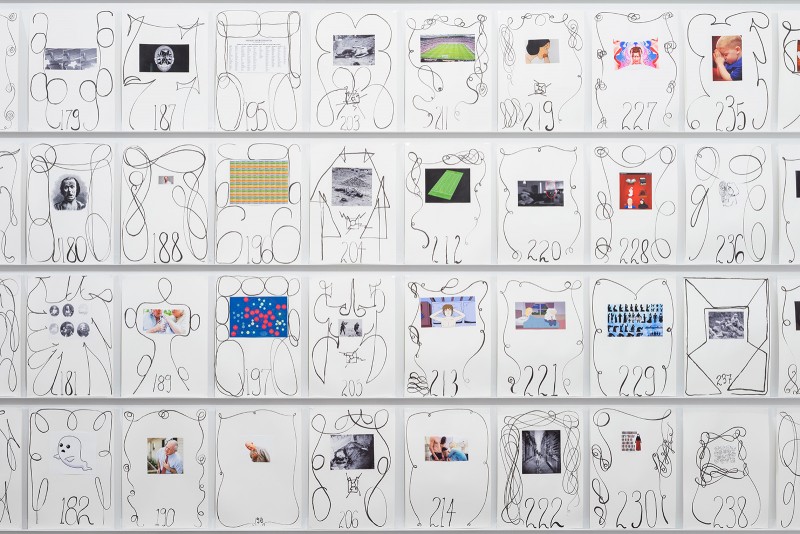
Initially, visitors can appreciate Matt Mullican’s exceedingly technical accuracy. But with a deeper view, they discern a universe of links and insinuations. These situational and figurative links seem to stage a presentness on the surface of the paper parallel and inherently connected to reality. I think they foster in an ambiguous sense even more the artist’s question of ‘”What is the meaning of things?” Or they ask, with Aby Warburg, “What is the visual memory of Western culture?” It seems to me that Matt Mullican doesn’t present ultimate solutions to these questions, but he ostensibly reveals a structural nexus behind the visual world driven by an archive of signs and symbols. Just our recognition and encirclement of crucial and somehow ancient issues can open our eyes to the complexity of Matt Mullican’s real and surreal worlds.
Matt Mullican was born 1951 in Santa Monica (U.S.) and currently lives in New York. With a bachelor’s degree in fine art from the California Institute of the Arts in Valencia, the artist has been exhibiting worldwide since the 1970s in renowned museums and galleries such as the Museum of Modern Art (New York), Whitney Museum (New York), Reina Sofia (Madrid), Museum Ludwig (Cologne), Centre Georges Pompidou (Paris), and Neue Nationalgalerie (Berlin).
Matt Mullican’s solo show at the Rosenwald-Wolf Gallery is on view until Feb. 26, 2016. Gallery hours are Monday to Friday: 10 am – 5 pm, and Saturday to Sunday: 12 pm – 5 pm.










